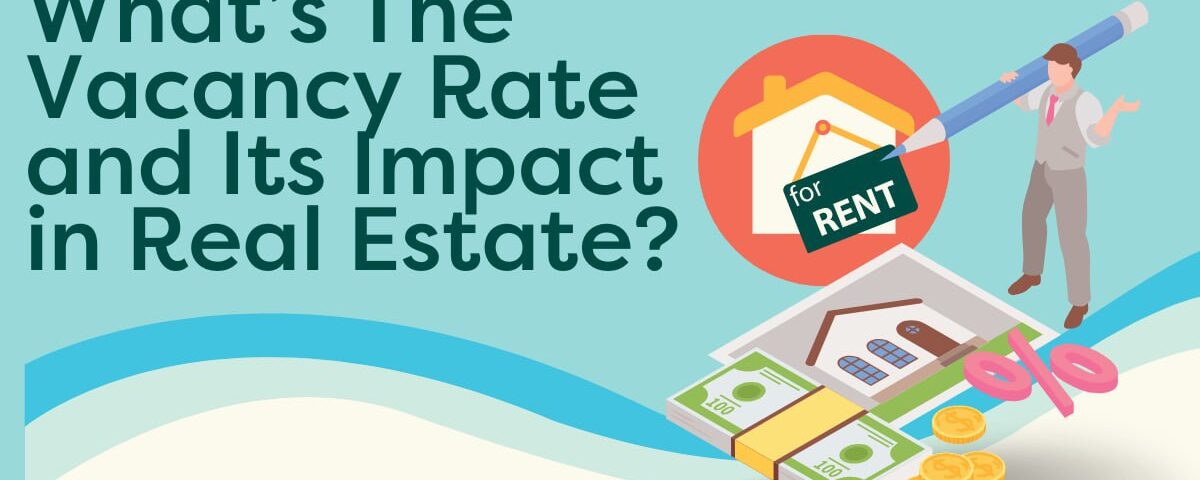What’s The Vacancy Rate and Its Impact in Real Estate?

What Are The Trends Shaping the 2024 Real Estate Market?
March 20, 2024How do you evaluate the potential rental income of a property?
March 22, 2024Vacancy rate and impact in real estate. Imagine a busy town with tall buildings lining the skyline, each one a symbol of human ambition and creativity. However, in the middle of this architectural wonder sits a quiet economic oscillator: the vacancy rate. This measure is very important in the real estate industry since it gauges investor mood and the state of the market. The vacancy rate is a clear indicator of supply and demand mismatches that shape real estate development. And investment environment as sunlight streams through vacant windows and echoes off empty walls.
It is more than simply a figure, it is an indicator of developing trends and an oracle that leads players through the maze-like property markets. Every space, from beautiful suburban homes to tall skyscrapers, reveals something about cultural dynamics and economic changes. Neighborhoods are affected, with an effect on property values, rental rates, and urban planning projects. Vacancy rates, whether rising or falling, influence developers, and investors. And legislators and determine the course of real estate markets and the cities they define.
Investment Decisions and Vacancy rate and impact in real estate
In real estate investing, vacancy rates are to landlords and property owners what the weather forecast is to the weatherman. There is tremendous demand and attractive returns while these rates are low, much like sunny skies ahead. On the other hand, rising vacancy rates are like storm clouds approaching. Indicating impending difficulties such as a squeeze on earnings and rental difficulties. In turn, this affects rental income and property values, which directly affects real estate returns. Thus, like with travel planning, astute investors use vacancy rates as a guide to successfully negotiate the real estate market. And make wise choices that result in profitable ventures and sunny days.
Property Appreciation
Consider the real estate market as a busy neighborhood where investors are guided by traffic lights provided by vacancy rates. Because low vacancy rates make a place desirable for everyone, demand for real estate in those locations soars above supply, driving up property values. This paves the way for investors to possibly profit handsomely in the future as real estate values rise. It’s similar to discovering a hidden jewel in a crowded city: you are sure it will be worthwhile in the long run and you know it is valuable. Knowing how vacancy rates affect the market is similar to having insider knowledge; it enables investors to identify the best chances for capital growth and success in the real estate market.
Market Selection
It seems like we’re all detectives searching for the finest possibilities in the world of real estate investment. Searching for hints that point us in the direction of the real action, we comb through vacancy rates. Low vacancy rates are an indication of strong demand and stable rental income, similar to finding a buried treasure. Given that there is a greater likelihood of long-term growth for our investment, these are the locations we wish to launch our business. In the ever-changing real estate market, success revolves around identifying the ideal location where supply and demand meet. In this regard, vacancy rates serve as our compass.
Rental Income and Vacancy rate and impact in real estate
Pumping with the rhythm of rental income for property owners, vacancy rates are like the heartbeat of the real estate market. Renters can benefit from increased rental incomes when vacancy rates are low, since it appears as though the market is in full bloom and teeming with eager tenants. Vacancy rates that spike, however, cause a gap in the rhythm, causing landlords to scramble to replace vacant premises and possibly seeing a decline in rental income. Smart real estate investors modify their strategies accordingly, looking for communities with low vacancy rates to maximize profits or coming up with original ideas to draw in renters in high-vacancy areas. Achieving a real estate plan that works requires a thorough understanding of the relationship between vacancy rates and rental revenue.
Low Vacancy Rates and Higher Rental Income
Low vacancy rates in the real estate market are like gold dust, indicating a hot market where supply is not keeping up with demand. Landlords benefit from tenants scrambling to acquire a location because there are fewer unoccupied properties available. Landlords may charge top dollar for their rentals because they know tenants will pay higher rates in a competitive market. It’s a win-win situation. Because there aren’t many options, landlords can negotiate hard to get the best possible price and increase their rental income. Vacancy rates are the unseen tool in the real estate game that may make a decent investment into a fantastic one.

High Vacancy Rates and Decreased Rental Income
A different picture is painted in real estate by high vacancy rates, which show that landlords have a difficult time finding tenants for their buildings. Tenants possess the power because there are so many options available to them, which incentivizes landlords to reduce rental prices or offer extras like free rent or reduced fees. Landlords are in a difficult situation because of the shrinkage of their rental income due to intense competition for available units. The dynamic nature of the real estate market means that vacancy rates play a crucial role in determining the power dynamics between landlords and renters as well as the profitability of individual property owners.
Policy Implications and Vacancy rate and impact in real estate
As decision-makers create housing and real estate policies, vacancy rates act as a compass. When vacancy rates are high, market revitalization interventions such as demand-boosting policies or development incentives are triggered. On the other hand, low vacancy rates encourage policymakers to concentrate on methods to increase the supply of affordable housing and fix shortages. Politicians can ensure a balanced approach to real estate development and housing supply by utilizing vacancy rate statistics to customize efforts to each market’s specific requirements. Property values and market dynamics are directly impacted by these policies, which also have an effect on real estate assets. It is therefore imperative that policymakers comprehend vacancy rates and the implications they carry in order to promote fair access to housing resources as well as sustainable growth.
Supporting Affordable Housing Initiatives
In rental markets, it’s a warning sign for affordability when vacancy rates reach an all-time low. Households with low and moderate incomes are feeling the pinch as competition pushes prices higher. Legislators intervene to address this issue and make sure housing is still accessible to everybody. They might strengthen rental assistance programs, increase funding for subsidized housing, or provide incentives to developers to construct affordable housing. Finding a place to call home for a family can be determined by vacancy rates, thus it all comes down to balancing the numbers in this market. Within the complex realm of real estate, vacancy rates are more than simply figures; they serve as an indicator of the prosperity and well-being of our community.
Monitoring Market Stability
Vacancy rates are comparable to the beating heart of our communities when it comes to real estate policymaking. They help legislators traverse the always shifting terrain by providing us with an insight into the state of our housing markets. Policymakers may anticipate obstacles, adjust their approaches, and guarantee. That everyone has an equal chance of locating a place to call home by closely monitoring vacancy patterns. It’s important to remain aware of local needs and ensure that the intended beneficiaries of our initiatives. Are receiving the benefits from them. Vacancy rates are the beat that keeps our cities alive and vibrant in the complex dance of real estate.
FAQs
Why is the real estate industry’s vacancy rate significant?
The vacancy rate serves as a guide for investment decisions and policy. Because it shows how supply and demand are balanced in real estate markets. High rates could indicate oversupply and possible difficulties, whilst low rates would indicate strong demand.
What effect does the vacancy rate have on owners of rental properties?
The impact of vacancy rates on rental income is direct. While high rates can result in lost income as landlords struggle to fill apartments and may need to lower rents to entice tenants, low rates lead to higher income owing to high demand.
